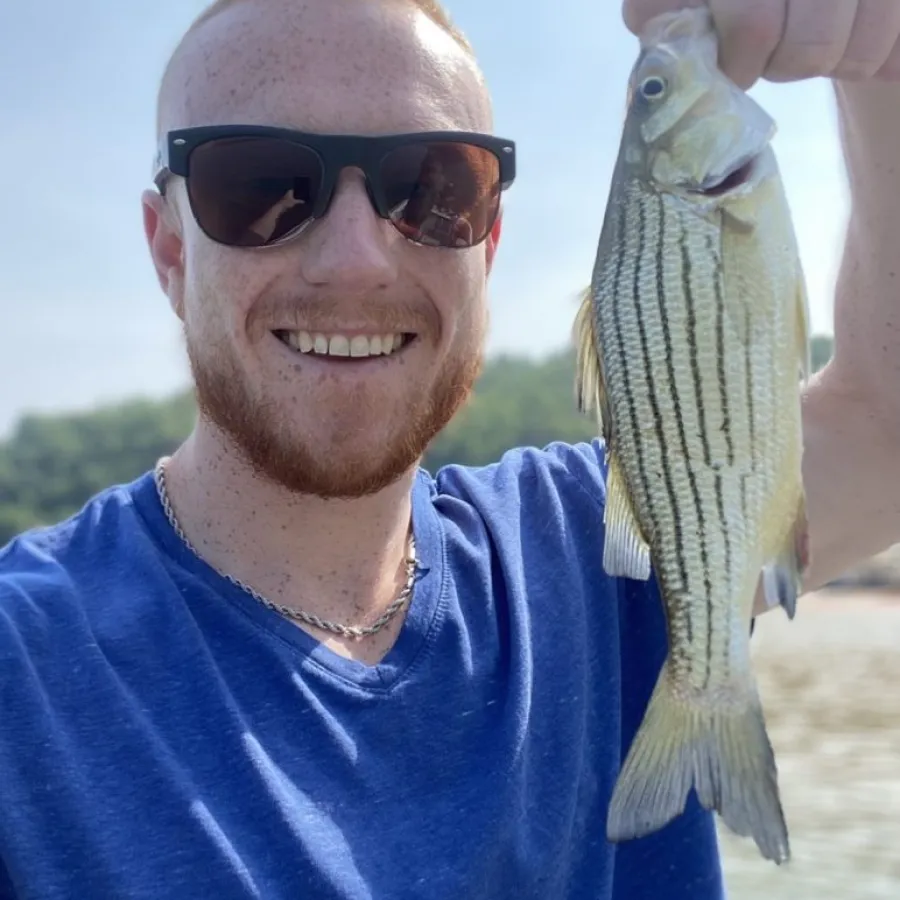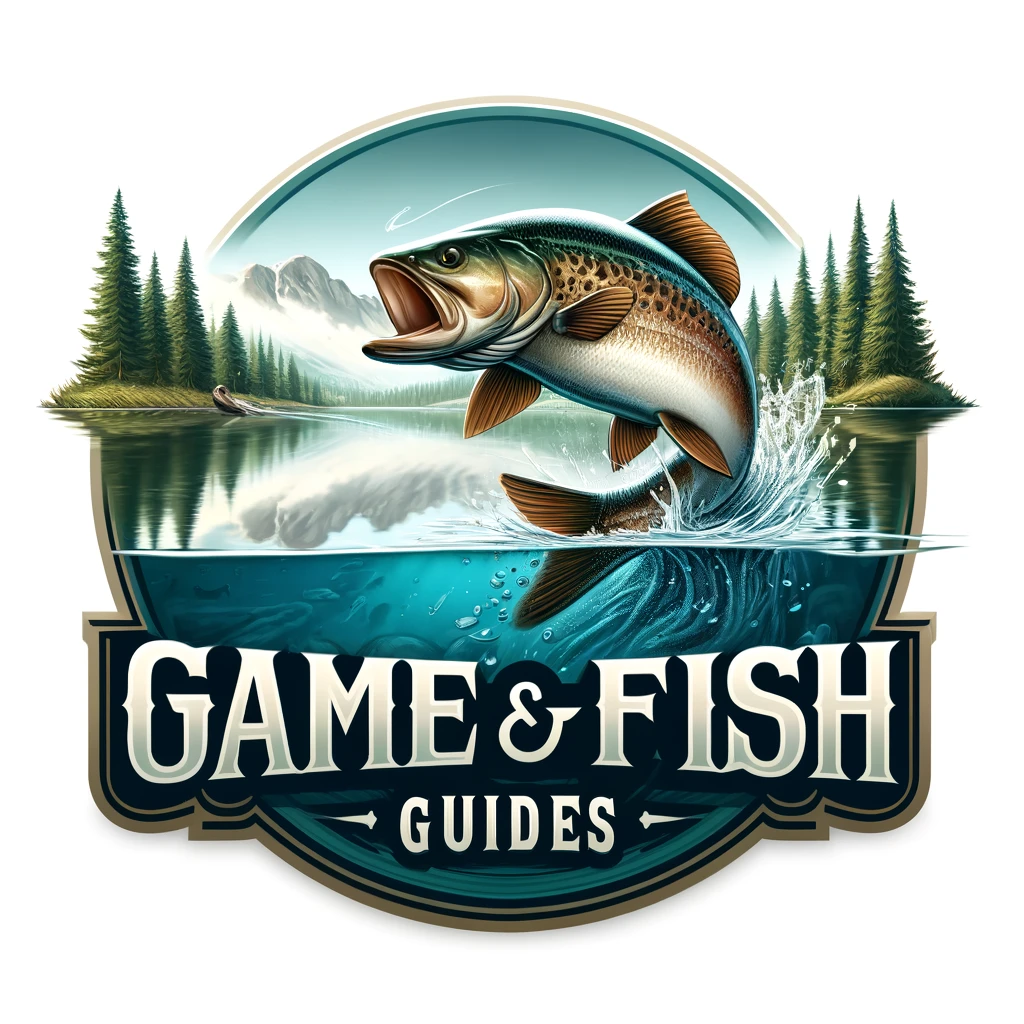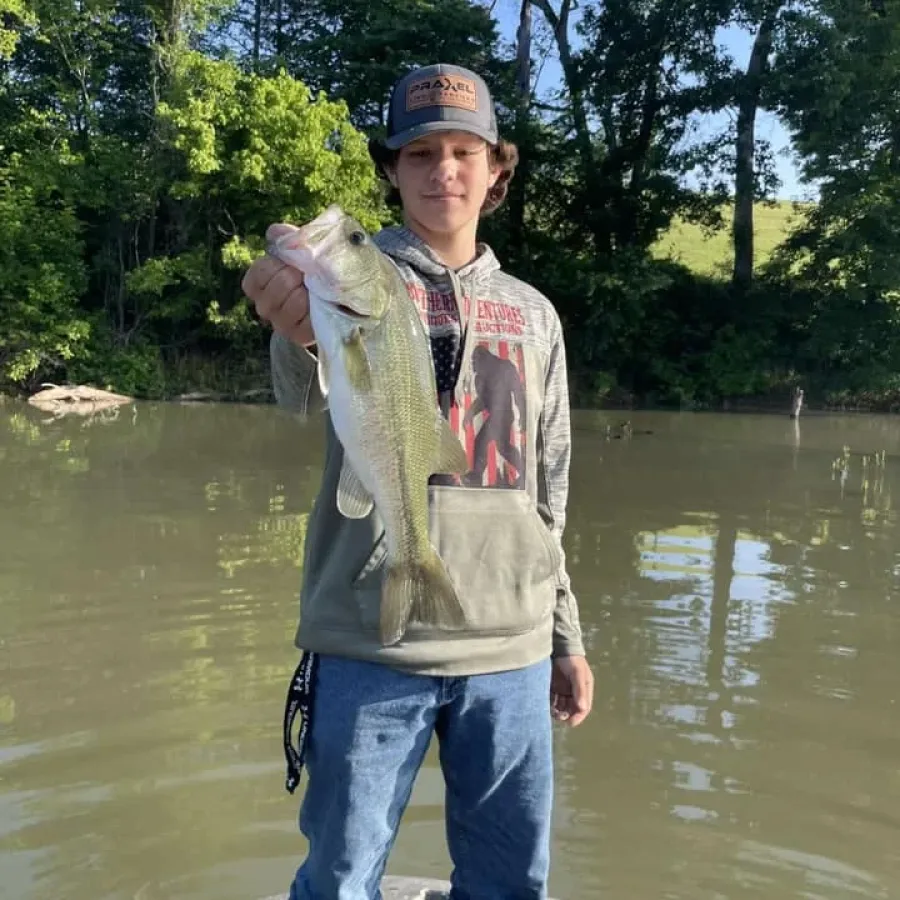This bass fishing resource guide will teach you how to catch all the big kinds of bass: largemouth, smallmouth, and striped. We will discuss tips for bass fishing such as where these fish like to hang out, what gear you should use, and the best ways to catch them. Doesn’t matter if you’ve been fishing for years or if you’re just starting—these tips will help you catch more bass. So, grab your fishing rod and let’s get started!
*Using our Amazon Affiliate links gives us a commission at no extra cost to you.
Largemouth Bass
The largemouth bass (Micropterus salmoides) is a very popular freshwater fish known for its exciting fishing qualities. Native to North America, it is one of the most popular sport fishing species.
Physical Characteristics
The Largemouth Bass is a big, strong fish with a really…well…large mouth. It can be different colors like dark green or brownish-green, and it has a white belly. There’s also a big black stripe that runs down the middle of its body. People call this stripe the “bass line”. This is not to be confused with the spotted bass, there are differences between spotted and largemouth bass that you should know.
Size and Weight
Largemouth Bass can grow to exceptional sizes, with their average length being 12-16 inches (30-40cm), they can reach over 2 feet (60cm) long under favorable conditions. Their weight can vary from a couple of pounds to over 20 pounds in exceptional cases.
Natural Habitat
Largemouth bass are commonly found in a variety of aquatic environments, such as lakes, ponds, rivers, reservoirs, and even slow-moving creeks. They prefer areas with ample cover like submerged vegetation, fallen trees, rocks, and aquatic structures where they can ambush prey and hide from predators.
largemouth bass fishing tips
Select the Right Gear
Use a Light to medium spinning or baitcasting rod and reel combo suitable for casting lures and handling the power of largemouth bass. Select the best Bass fishing line in the range of 6-20 lb test, depending on the cover and size of bass you’re targeting.
Best Lures For Largemouth Bass
Largemouth bass can be caught using a variety of lures such as crankbaits, soft plastics like poppers and frog lures, jigs, and spinnerbaits. The choice of lure depends on the conditions, water clarity, and the bass’s feeding behavior. This involves trial and error, but if you’re wondering what’s the best lure for bass, it often depends on these factors.
Best Time of Day to Fish for Largemouth Bass
Early morning and late afternoon are prime times for bass activity, as they tend to be more active during low-light conditions. Night fishing for bass can also be extremely effective.
However, they can be caught throughout the day, they tend to travel along the shoreline in packs of 3-4 to hunt. When you see them traveling together like this, throwing bait at them is almost foolproof.
Bass fishing tips on technique
- Topwater Fishing: Use topwater lures like poppers or frog lures to imitate prey on the water’s surface. Cast near cover and retrieve. The goal here is to disrupt the surface and catch the attention of the bass.
- Soft Plastics: You can use a Ned Rig, Neko Rig, Texas rig or a Carolina rig with soft plastic baits. Just throw them in the water and let them sink. Then pull them back slowly and give them a little jerk now and then. You can use different kinds of soft baits like plastic worms, fake frogs, and swimming baits that jerk around.
- Use a Crankbait: Cast these crankbaits out to quickly cover a lot of water. Change how fast you reel them in to find where the bass are hanging out. Crankbaits are easy to use, so they’re a really good choice if you’re new to fishing. There are different kinds, like lipless crankbaits, deep diving crankbaits, and square bill crankbaits. The size of the lip on the crankbait shows you how deep it will go underwater. I’d say get a bunch that can go to different depths. One day, the fish might be in shallow water, and the next day they might be deeper. Being able to change how deep your crankbait goes can help. As you reel them in, change your speed, pause sometimes, and give it a little jerk; don’t just bring it in at the same speed all the time.
- Jigs: Throw jigs close to things like fallen trees or rocks in the water. Let them sink. Then, move them a little bit to make them look like something a fish would want to eat. I like to throw my jigs next to downed trees and let them go all the way to the bottom. If a fish doesn’t bite right away, I bring the jig back fast and try a different spot, doing the same thing again. But if I’m still not getting any bites, I switch up how I’m moving the jig. I like to use skirted jigs and hair jigs, and I use different colors to see what works best.
Presentation Matters
Cast accurately to specific spots where bass might be hiding, such as under overhanging trees, around submerged vegetation, or near drop-offs. In general, casting right to the shoreline and retrieving it is a foolproof way to catch bass almost anywhere.
Experiment with different retrieve speeds and movements to figure out what triggers the bass’s interest. Generally, the warmer the water the faster and more erratic you should make your presentation. If you’re looking for good bass fishing lures and have tried various options already, consider something unique such as rat lures for bass for something different. And don’t forget about weedless bass lures when you’re fishing in areas with a lot of vegetation.
Smallmouth Bass
The smallmouth bass is a freshwater fish that people love to catch because it fights hard and looks unique. It comes from North America and is popular for fishing. If you want to get better at catching smallmouth bass, here’s what you need to know:
Appearance
- Smallmouth bass have a long, thin body and a smaller mouth compared to largemouth bass.
- Their colors can vary depending on their environment, but they typically have shades of bronze, brown, or olive on their backs, transitioning to silver/white shades on their sides and bellies.

Size
Smallmouth bass typically range in size from around 12 to 20 inches (30 to 50 cm) in length. In rare cases, trophy smallmouth bass can exceed 20 inches and weigh several pounds.
Habitat
Smallmouth bass are commonly found in clear or moderately clear freshwater habitats such as rivers, streams, lakes, and reservoirs. They prefer rocky or gravel bottoms and structures, including submerged rocks, boulders, and underwater ledges.
How to Catch Smallmouth Bass
The good news is that all of the same equipment used for Largemouth Bass can be used for Smallmouth Bass. The biggest difference between fishing for Smallmouth and Largemouth is when. Largemouth can be caught readily during the heat of the summer, whereas it’s much more difficult to land a Smallmouth during this time. The best time for Smallmouth fishing is late winter/early spring as well as fall. They can still be caught during the summer, but you are going to be focusing on deep water, especially near rocky dropoffs into deep water, as well as deeper structures.
Gear Up
Use a light to medium spinning or baitcasting rod and reel combo that can handle the fight of smallmouth bass. Use a fishing line in the range of 4-8lb test for better sensitivity and control.
Spot the Location
Smallmouth bass are often found in clear or moderately clear waters of rivers, streams, lakes, and reservoirs. Look for rocky structures, underwater ledges, submerged rocks, and drop-offs, as these are favored hiding spots for smallmouth bass.
the best Smallmouth Bass lures
Smallmouth bass can be caught using a variety of lures, including soft plastics (tubes, grubs), crankbaits, jigs, spinnerbaits, and topwater lures. The choice of lure depends on the water clarity, season, and fishing conditions.
Best Time of Day to Fish for Smallmouth Bass
Smallmouth bass are often more active during the early morning and late afternoon. However, they can be caught throughout the day, especially in cooler water temperatures.
best techniques for smallmouth
- Tube Baits: Rig a tube bait on a jighead and work it along the bottom near rocky structures. Allow it to imitate a crayfish, a staple of the smallmouth bass diet.
- Crankbaits: Use diving crankbaits at various depths. When one color is not producing any fish, select a color that is much different than the current one.
- Topwater Lures: Try topwater lures like poppers or frogs.
- Jigs: Pitch jigs near underwater structures and try a variety of different retrieval speeds and movements.
- Spinnerbaits: Cast spinnerbaits along drop-offs or in rocks.
Presentation Tips
Cast accurately and directly into structures of any kind where they may be hiding out. Slow down your presentation and experiment with different retrieval speeds and techniques. If one way doesn’t work, try another one. If you have a boat, trolling can be an effective strategy too, and it covers more water. Experiment with different speeds here as well.
Adapt and Conquer
If you’re not getting bites, try changing lures, colors, or presentation techniques until you find the right combination. These variables can change in only a day, something that worked yesterday won’t get any bites the next day.
Striped Bass
The striped bass, also called “stripers,” are a fish people really like to catch. They’re strong, get very big, and you can find them in both fresh and saltwater. Here’s what you need to know:
Appearance
Striped bass have a special look. They are long and thin, and have a tail that splits into two parts. They have dark black stripes going sideways along their body.
Species Identification
Be careful, Striped Bass look a lot like White Bass, and sometimes they even mix to make a new kind. This can make it hard to tell them apart. Striped Bass usually have long, thin bodies and strong black lines on their sides. They also get much bigger. On the other hand, the White Bass and the mixed ones have fatter bodies, and their lines look faded or not all there.

Size
Striped bass can vary widely in size. They can range from a few pounds to well over 50 pounds or more. In places like the Atlantic coast, striped bass can get massive. Some can weigh more than 60 or even 70 pounds. Usually, the ones in the ocean are bigger than the ones you find in lakes or reservoirs.
Habitat
Striped bass are found in brackish waters, saltwater coasts, and freshwater rivers and reservoirs. They are known for their anadromous behavior, which means they migrate from the ocean into freshwater rivers and estuaries to spawn.
Behavior and Diet
Striped bass are meat-eaters that hunt other fish. They mostly eat fish like herring, menhaden, and shad. What they eat can change depending on where they are swimming.
How to Catch Striped Bass
This will largely depend on where you’re fishing. Fishing for these fish is different than fishing for Smallmouth or Largemouth Bass. In general, Stripers are harder to catch because they move around a lot during the year. So, the first step is figuring out where they are.
Seasonal Patterns and Habitats
In saltwater, you can find striped bass near the shore, in shallow water, in places where rivers meet the sea, and near things like big rocks and jetties.
In lakes and big ponds, Striped Bass go up smaller rivers and big creeks in the early spring or late winter to lay eggs. After laying eggs and when the water gets warmer, they go back to the big parts of the lake. When they’re laying eggs, try fishing in the rivers and creeks that go into the lake. Look for spots where the water suddenly gets deep or where there are things like big rocks. You can also troll slowly through the creeks to check more places. In the summer and fall, do the same thing but in the big parts of the lake.
Learn about the local seasons, migrations, and preferred habitats in your area.
Best Time of Day to Fish for Striped Bass
The best times to catch striped bass are often just as the sun is coming up in the morning and just before it sets in the evening. During these times, the water is cooler and the fish are more active, looking for something to eat. In the morning, try fishing between dawn and about two hours after the sun comes up. In the late afternoon, start about two hours before the sun sets and keep fishing into the early evening. These are the times when you’re most likely to find striped bass closer to the shore and willing to bite.
Tackle Selection
The best striped bass rod and reel combo will be a medium-heavy to heavy rod and a reel with a strong drag systems. Depending on the fishing environment, choose a monofilament or braided fishing line with a sufficient pound test. The best fishing line for striped bass will be at least 20lb mono, and 40lb braid. If you are fishing in saltwater and targeting larger fish, you might even go heavier. Be sure to follow your reel line/yd rating to ensure optimal functionality of your gear. If you prefer mono line, I’d suggest Berkley Big Game, and if you’re a braided fan I’d suggest Power Pro.
Best Bait and Best Lures For Striped Bass
Live bait for saltwater: Popular live baits include baitfish like bunker (menhaden), herring, eels, and even clams or squid.
Live bait for freshwater: Gizzard Shad, American Shad, Threadfin Shad, Herring, and Shiners. Make sure the bait you select is native to the water you’re fishing.
Artificial Lures: Topwater lures, swimbaits, jigs, spoons, and soft plastics (with jigheads) can all be effective for targeting striped bass. Most experienced Striper guides and anglers prefer to use live bait, especially in reservoirs.
Trolling for Striped bass
Trolling for striped bass is a common method for locating and catching them in open water. Use deep-diving plugs, umbrella rigs, or tube-and-worm rigs when trolling.
When using umbrella rigs, the best strategy is to troll with multiple rods, using different colored and sized trailers on each rod. Vary your trolling speed, distance from the boat, and depth until you find where the fish are.
Casting and Retrieving
Cast lures near structures like points, rocks, jetties, bridge pilings, and submerged features where striped bass might be hiding. Retrieve your line with a mix of different lure presentations. If one presentation is not producing fish, change it up.
Live Bait Fishing
Hook live bait through the lips or the back above the lateral line and below the Dorsal fin to allow it to swim naturally. Adjust the weight based on the water depth and current.
Night Fishing for Striped Bass
Striped bass are often more active during low-light conditions, including early morning, late afternoon, and night. This is especially true during the hot summertime. Night fishing with live bait, lures, or glow-in-the-dark lures can be productive, however, fishing in the dark can be difficult.
FAQ
Do bass have teeth?
Yes, bass do have small teeth that feel like sandpaper. The most damage they could do is cause what is called “bass thumb”, which just means that the teeth rubbed your skin and made it a little rough feeling.
Can you eat eat Largemouth bass?
Absolutely yes, they are underrated in my opinion, they have a very good amount of flavor, not too bland, but not too fishy.
Wrapping Up
This bass fishing guide has covered a lot about the three kinds of bass: smallmouth, largemouth, and striped. Each one is special in its own way. Smallmouths have long, skinny bodies. Largemouth can get super big and have a big mouth. Striped bass can get huge have stripes and can live in both fresh and salt water.
We also talked about the best lures for bass, like crankbaits and jigs. Don’t forget, the best time of day to fish for bass is usually early morning or late afternoon. If you’re dreaming about how to catch big bass, remember each type has its own tricks to get them on your hook.
So now you’re ready. Grab your fishing gear and let’s catch some bass!

